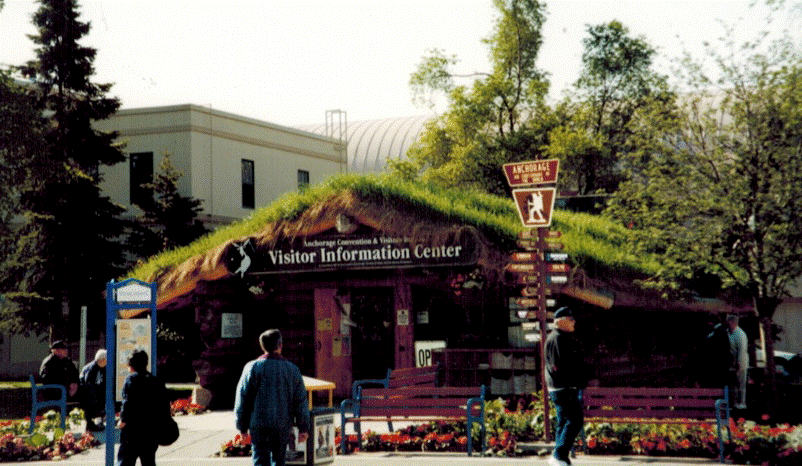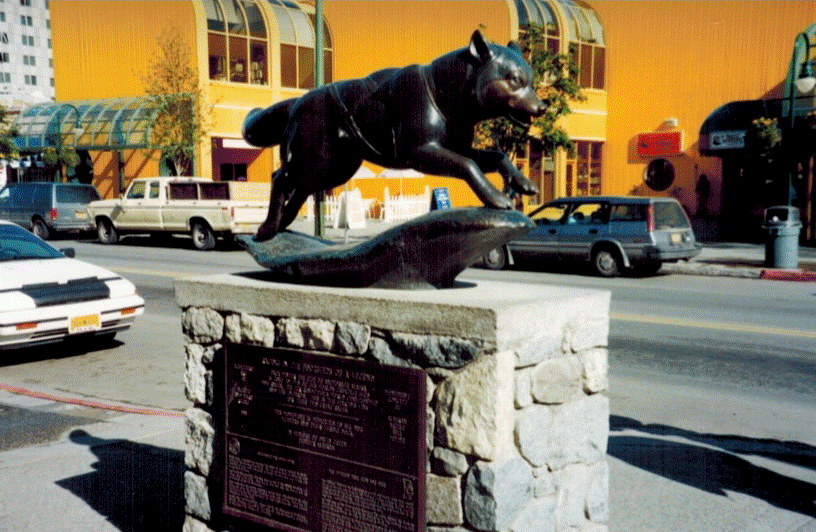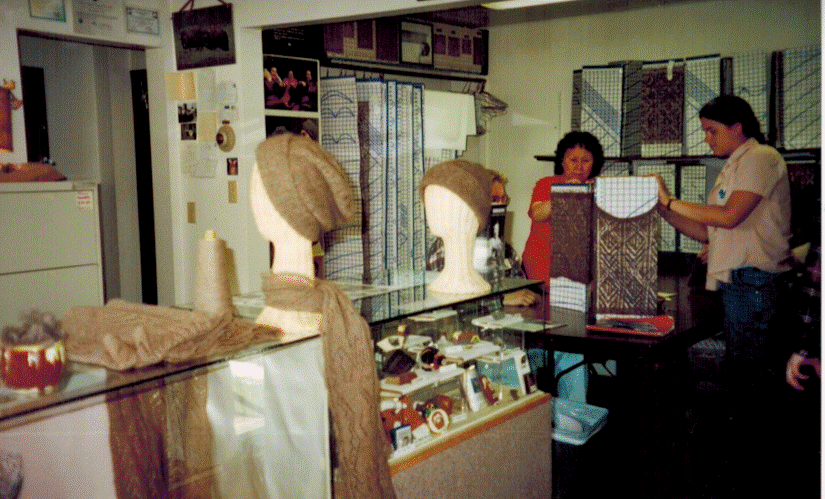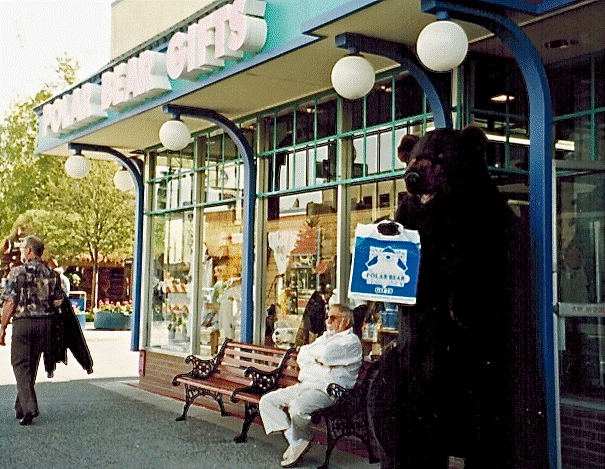BY: JANET STEINBERG
ANCHORAGE, a sophisticated metropolis with frontier Alaska in
its backyard, is a fascinating mixture of human cultures and a
rich natural history carved out by glaciers and volcanoes. Alaska’s
largest city, with a 2011 population of 295,570, contains approximately
50% of the entire state’s population.
Alaska’s
birth and boom is directly related to its wealth of
natural resources: gold, lumber, fur and oil. Some settlers came
to Alaska as miners, loggers or hunters. Some came because
they realized their potential as traders, wholesalers and merchants in
this rich frontier land.
birth and boom is directly related to its wealth of
natural resources: gold, lumber, fur and oil. Some settlers came
to Alaska as miners, loggers or hunters. Some came because
they realized their potential as traders, wholesalers and merchants in
this rich frontier land.
Northern
Lights dance above a mirrored highrise that reflects a sod-roofed log
cabin; four-wheel drive trucks share parking lots with Mercedes
roadsters; rugged flannel-shirted “sourdoughs”
(native Alaskans or one who has survived an Alaskan
winter) buy Alaskan lynx coats for their
pioneering women.
Lights dance above a mirrored highrise that reflects a sod-roofed log
cabin; four-wheel drive trucks share parking lots with Mercedes
roadsters; rugged flannel-shirted “sourdoughs”
(native Alaskans or one who has survived an Alaskan
winter) buy Alaskan lynx coats for their
pioneering women.
 |
|
AUTHENTIC
SOD-ROOFED LOG CABIN |
And
the best place to buy that Alaskan lynx is at David Green, Alaska’s Master
Furrier. David Green, is a family operated business run by the grandson
of David Green who founded the company in 1922 when Alaska was still
a territory.
the best place to buy that Alaskan lynx is at David Green, Alaska’s Master
Furrier. David Green, is a family operated business run by the grandson
of David Green who founded the company in 1922 when Alaska was still
a territory.
When
it’s time to tour, begin at the Anchorage Museum of History
& Art (121 W. 7th Ave.) which showcases a permanent
collection depicting 10,000 years of Alaska history. The museum
also displays works of Alaskan art from travelers, adventurers and
native artists.
it’s time to tour, begin at the Anchorage Museum of History
& Art (121 W. 7th Ave.) which showcases a permanent
collection depicting 10,000 years of Alaska history. The museum
also displays works of Alaskan art from travelers, adventurers and
native artists.
The Oscar
Anderson House-Elderberry Park (420 M Street) is the only house
museum in Anchorage. The building was one of the city’s
first wood frame house, built in 1915 by Swedish immigrant
Oscar Anderson.
Anderson House-Elderberry Park (420 M Street) is the only house
museum in Anchorage. The building was one of the city’s
first wood frame house, built in 1915 by Swedish immigrant
Oscar Anderson.
Resolution
Park (end of 3rd Ave. at L Street)contains a life-size statue
of Captain James Cook overlooking Cook Inlet where he anchored in
1778. The monument commemorates the 200th anniversary of
Cook’s exploration of the area on his third and final voyage.
Park (end of 3rd Ave. at L Street)contains a life-size statue
of Captain James Cook overlooking Cook Inlet where he anchored in
1778. The monument commemorates the 200th anniversary of
Cook’s exploration of the area on his third and final voyage.
“And behold…the
earth did quake, and the rocks Rent.” The city’s
most sobering sight is Earthquake Park, overlooking
Cook Inlet. The park’s broken ground stands in
evidence of the Good Friday earthquake of March 27, 1964. In four
minutes, 24,000 square miles of the earth’s surface were raised or lowered
an average of 3 to 8 feet.
earth did quake, and the rocks Rent.” The city’s
most sobering sight is Earthquake Park, overlooking
Cook Inlet. The park’s broken ground stands in
evidence of the Good Friday earthquake of March 27, 1964. In four
minutes, 24,000 square miles of the earth’s surface were raised or lowered
an average of 3 to 8 feet.
The
1964 earthquake, the strongest quake ever recorded in North
America (9.2 on the Richter), had more impact on Anchorage than any
other event in its history. Young Alaskans quickly
sprang back, rebuilt the community and went on developing
America’s last frontier.
1964 earthquake, the strongest quake ever recorded in North
America (9.2 on the Richter), had more impact on Anchorage than any
other event in its history. Young Alaskans quickly
sprang back, rebuilt the community and went on developing
America’s last frontier.
On 4th Avenue, where the annual Iditarod Dog Race begins, the David
Green Furrier family placed a sculpture of a husky dog. The
inscriptions reads: ” ‘Racing in the Footsteps of a
Legend’. Monument dedicated to all dog mushers and their
heroic dogs. In memory of David Green
Pioneer Alaskan.”
 |
|
HUSKY
DOG IN MEMORY OF DAVID GREEN |
Lake
Hood, and the adjacent harbor is the largest and busiest
floatplane base in the world, with more than 800 take offs and
landings on a peak summer day. In a state where approximately 1
out of every 68 Alaskans are licensed pilots, it’s not surprising
that each year more than 230,000 pontooned planes take off or
land from this base. In the winter, the floats are
replaced by skis. Providence Hospital has a heliport for emergency
patients flown in from rural Alaska, also known as “the
bush”.
Hood, and the adjacent harbor is the largest and busiest
floatplane base in the world, with more than 800 take offs and
landings on a peak summer day. In a state where approximately 1
out of every 68 Alaskans are licensed pilots, it’s not surprising
that each year more than 230,000 pontooned planes take off or
land from this base. In the winter, the floats are
replaced by skis. Providence Hospital has a heliport for emergency
patients flown in from rural Alaska, also known as “the
bush”.
On
the south shore of Lake Hood is the Alaska Aviation
Heritage Museum. Here you can see 21 vintage aircraft
and learn about the state’s unique aviation history.
the south shore of Lake Hood is the Alaska Aviation
Heritage Museum. Here you can see 21 vintage aircraft
and learn about the state’s unique aviation history.
Time
permitting, it’s worthwhile to take a drive east into the
fertile farmland of the Matanuska Valley. (Gray Line
of Alaska offers superior tours.) The rolling lands are an
unexpected change from the rugged snow capped mountains. In
1935, families from the Midwest, reeling from the dust bowl and then
the Great Depression, homesteaded in Palmer forming the first
Alaskan community based on agriculture.
permitting, it’s worthwhile to take a drive east into the
fertile farmland of the Matanuska Valley. (Gray Line
of Alaska offers superior tours.) The rolling lands are an
unexpected change from the rugged snow capped mountains. In
1935, families from the Midwest, reeling from the dust bowl and then
the Great Depression, homesteaded in Palmer forming the first
Alaskan community based on agriculture.
This
rich Land of the Midnight Sun is known for growing
giant vegetables. Cabbages have been recorded as large
as 73-pounds. A world-record turnip grew to 50-pounds
and a carrot weighed in at 17-pounds. Cabbages must weigh a
minimum of 50-pounds just to compete in the State Fair. The
famous Alaskan-Texas rivalry reared its head when Alaskans sent
a 66-pound cabbage to the Texas State Fair in a crate labeled
“Brussels Sprout”.
rich Land of the Midnight Sun is known for growing
giant vegetables. Cabbages have been recorded as large
as 73-pounds. A world-record turnip grew to 50-pounds
and a carrot weighed in at 17-pounds. Cabbages must weigh a
minimum of 50-pounds just to compete in the State Fair. The
famous Alaskan-Texas rivalry reared its head when Alaskans sent
a 66-pound cabbage to the Texas State Fair in a crate labeled
“Brussels Sprout”.
For
a glimpse of the Native Athabascan culture and the influence
of Russian Orthodox missionaries, visit the Eklutna Historical Park,
30 miles north of Anchorage. A sacred burial ground of the
Dena’ina (also called Tanaina) Athabascans contains more than 80
dollhouse-like spirit houses that look as if they were built
by Santa’s elves. These multi-colored houses are built
above each grave.
a glimpse of the Native Athabascan culture and the influence
of Russian Orthodox missionaries, visit the Eklutna Historical Park,
30 miles north of Anchorage. A sacred burial ground of the
Dena’ina (also called Tanaina) Athabascans contains more than 80
dollhouse-like spirit houses that look as if they were built
by Santa’s elves. These multi-colored houses are built
above each grave.
The historic old log St. Nicholas Russian Orthodox Church stand
a few feet from the new yellow and white frame church. On
a few Indians from the Athabascan tribe still live in the
village. However more than 100 are still on
the tribal roles. Here, too, is the Heritage House
Museum.
Just
north of Palmer is the country’s only Musk Ox
Farm where you can get a close look at the shaggy
prehistoric-looking animals that look like a cross between a sheep
and a water buffalo. Their soft grayish brown wool,
called qiviut (pronounced key-vee-ute), is knitted into hats,
scarves and other clothing by Native Alaskans.
north of Palmer is the country’s only Musk Ox
Farm where you can get a close look at the shaggy
prehistoric-looking animals that look like a cross between a sheep
and a water buffalo. Their soft grayish brown wool,
called qiviut (pronounced key-vee-ute), is knitted into hats,
scarves and other clothing by Native Alaskans.
 |
|
HATS
AND SCARVES HANDKNIT FROM THE RARE QIVIUT FIBER |
An
ounce of qiviut is eight times warmer than an equal amount of
sheep’s wool. The wool of the rare musk ox is
extremely costly. However, the proud owner knows she
possesses a garment from the rarest textile fiber on earth.
ounce of qiviut is eight times warmer than an equal amount of
sheep’s wool. The wool of the rare musk ox is
extremely costly. However, the proud owner knows she
possesses a garment from the rarest textile fiber on earth.
Back
in Anchorage you can buy your qiviut masterpieces
at Oomingmak, located in the little brown house with the musk ox
mural (corner of 6th Ave. & H Street). Over 200
Eskimos in this native owned cooperative (since 1969) hand-knit these
wearable masterpieces in exclusive Alaskan village patterns.
in Anchorage you can buy your qiviut masterpieces
at Oomingmak, located in the little brown house with the musk ox
mural (corner of 6th Ave. & H Street). Over 200
Eskimos in this native owned cooperative (since 1969) hand-knit these
wearable masterpieces in exclusive Alaskan village patterns.
 |
|
OOMINGMAK
COOPERATIVE |
A
stop at Laura Wright’s Alaskan Parkas is
also worthwhile. Laura Wright parkas are expensive,
but authentic.
stop at Laura Wright’s Alaskan Parkas is
also worthwhile. Laura Wright parkas are expensive,
but authentic.
And,
to assure authenticity in whatever you buy throughout Alaska, be sure
to look for one of two official symbols: The “Silver Hand”
emblem indicates the item was hand crafted by an Alaska Eskimo, Aleut, or
Indian craftsperson/artist. The “Made in Alaska”
emblem indicates that the article was made in Alaska by a resident artist,
craftsperson or manufacturer. Wherever possible, items bearing
these emblems have been made with Alaskan materials.
to assure authenticity in whatever you buy throughout Alaska, be sure
to look for one of two official symbols: The “Silver Hand”
emblem indicates the item was hand crafted by an Alaska Eskimo, Aleut, or
Indian craftsperson/artist. The “Made in Alaska”
emblem indicates that the article was made in Alaska by a resident artist,
craftsperson or manufacturer. Wherever possible, items bearing
these emblems have been made with Alaskan materials.
 |
POLAR
BEAR GIFTS ANCHORAGE’S LARGEST GIFT STORE SINCE 1992 |
JANET STEINBERG is an
award-winning Travel Writer and a Travel Consultant affiliated with
The Travel Authority, Mariemont/Cincinnati, Ohio office.
award-winning Travel Writer and a Travel Consultant affiliated with
The Travel Authority, Mariemont/Cincinnati, Ohio office.
